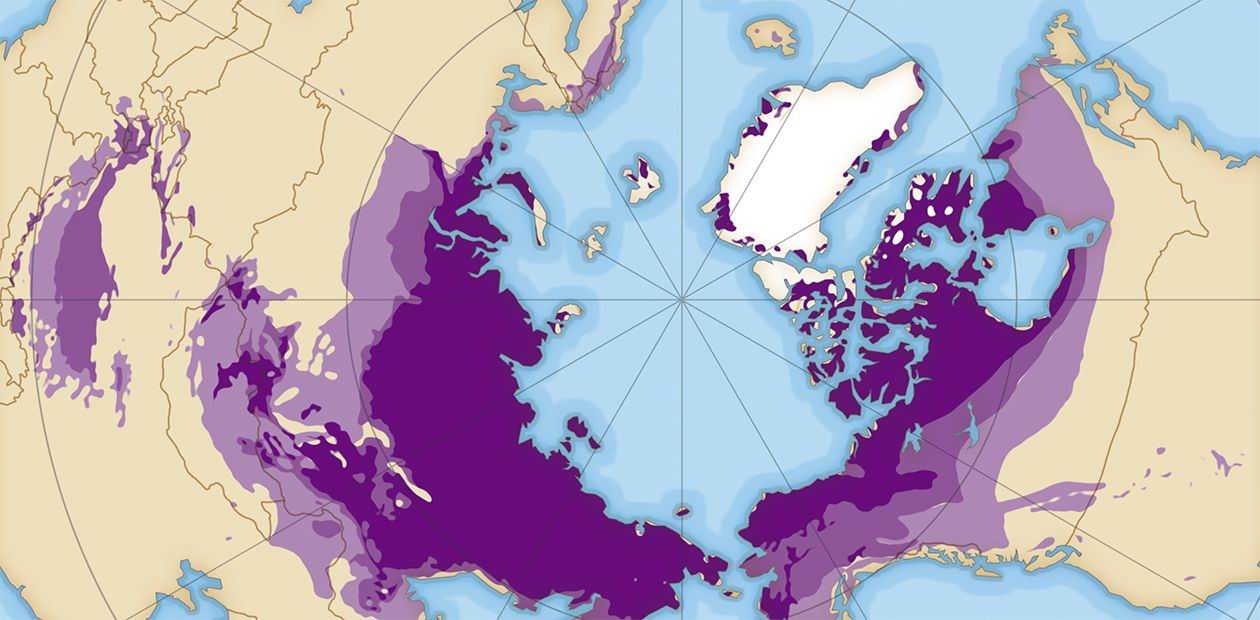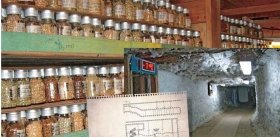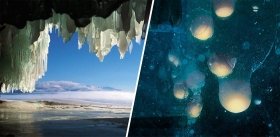We Live on a COLD Planet
There is hardly another natural factor that would have such a dramatic effect on the plant and animal worlds of the Earth as low temperatures. Only the tropical zone of our planet, except for its high-altitude regions, does not experience the action of cold.
The adverse effect of negative temperatures on organisms appears as a weakening of their life activities, arrest of metabolism, and damages caused by the ice grains formed in their cells and tissues.
During the last 100 years, a large number of facts related to the tolerance of higher organisms to cold have accumulated. In particular, it has been found that certain plants and animals are capable of surviving even when the water in their bodies transforms into crystalline ice. For example, caterpillars of some butterflies freeze-treated beforehand revived after a long-term freezing at a temperature of –78 to –269 °C. Many worms, including helminthes, also remain viable after freezing. The water flea Chydorus sphaericus, a member of the zooplankton found at a depth of 3.5 m in permafrost several thousand years old, revived too (Kapterev, 1936).
There is hardly another natural factor that would have such a dramatic effect on the plant and animal worlds of the Earth as low temperatures. Only the tropical zone of our planet, except for its high-altitude regions, does not experience the action of cold.
Characteristic of the periods of global cooling in the history of the Earth, connected with the development of glacial cover and narrowing of the climatic zones, were tremendous changes in the geographic ranges of plants and animals and their extinction. As a result, systems of different levels based on a cyclic (winter–summer or ice age–interglacial period) turnover of the biological matter and energy formed in the so-called cryogenic landscapes.
The adverse effect of negative temperatures on organisms appears as a weakening of their life activities, arrest of metabolism, and damages caused by the ice grains formed in their cells and tissues. There are three temperature ranges providing the existence of stable cryosystems, each displaying specific features for the life activities of organisms:
• From 0 to –20 °C, when living cells can be active;
• From –20 to –80 °C, when organisms are in anabiosis; and
• Below –80 °C (this temperature does not occur on the Earth under natural conditions), when biological objects are completely conserved.
(Lozina-Lozinsky, 1972):
The Minus Compatible with Life
P. I. Bakhmet’ev, a Russian scientist who studied the supercooling of insects and anabiosis (the phenomenon of suspended animation) of bats, laid scientific foundations of cryobiology as early as at the end of the 19th century.
During the last 100 years, a large number of facts related to the tolerance of higher organisms to cold have accumulated. In particular, it has been found that certain plants and animals are capable of surviving even when the water in their bodies transforms into crystalline ice. For example, caterpillars of some butterflies freeze-treated beforehand revived after a long-term freezing at a temperature of –78 to –269 °C. Many worms, including helminthes, also remain viable after freezing. The water flea Chydorus sphaericus, a member of the zooplankton found at a depth of 3.5 m in permafrost several thousand years old, revived too (Kapterev, 1936).
The large wood frog Rana sylvatica, living in Alaska, is able to hibernate deeply, with its temperature lowering to –6 °C without any detriment to its “health” (Storey, Kenneth, 1990). Perhaps, this frog is the living organism closest to humans, wgich is capable of surviving a true freezing.
Plants also survive a long-term freezing; for this purpose, they make “special arrangements”. It is appropriate to mention that the tolerance of many terrestrial organisms to sub zero temperatures over the entire life cycle depends on the season. For example, cold-hardening of plants, i. e., development of their frost tolerance, occurs only in the fall, when plants stop growing. The trees that endure the frost to –60 °C in winter (larch, spruce, and pine) die at a temperature of –7 to –8 °C in summer. Most likely, Russian farmer E. A. Grachev was the first to apply freeze-treatment to plants as early as at the end of the 19th century. He kept corn grains in snow for two weeks before planting and succeeded in producing mature corn ears under climatic conditions of St. Petersburg.
Certainly, many microorganisms (bacteria and yeasts) survive well low and even superlow temperatures. Actually, this ability underlies methods for their long-term storage. Tolerance to frost is usually provided by dehydration, increase in the viscosity of the cytoplasm, and by the presence of an envelope that prevents ice crystals from entering the cell.
The freezing point of the water containing various ions is below 0 °C and depends on the concentration of the substances dissolved. In the case of a slow freezing of cells, their content can retain its liquid state at a temperature that is considerably lower than the freezing point of the corresponding solution. This phenomenon is known as supercooling. The water inside cells in certain cases does not freeze even at a temperature of –20 °C. This was demonstrated by the example of the gastropod mollusks Mytilus edulis and Littorina rudis (Kanwisher, 1955).
The so-called cryoprotectors are used for preservation of living systems under low temperatures. They weaken the effect of crystallization by changing its pattern, prevent agglutination and denaturation of macromolecules, and enhance the preservation of cell membrane integrity. For example, when freezing sperm, it is recommended to add glycerin, egg yolk, or dimethylsulfoxide to protect spermatozoids against cold damage.
Keeping cool
Numerous studies into the ability of microorganisms to exist for a long time under extreme environmental conditions have recently appeared. Biologists from the University of Pennsylvania (USA) discovered live bacteria in the salt crystals 250 million years old (Vreeland et al., 2000). There are no special studies connected with the search for living microorganisms in ancient rocks, which suggests that the age of the most ancient living organisms on the Earth may be even more impressive.
Bacteria possess an amazing ability to form spores in adverse conditions, thereby turning into “structures” covered with a hard armature and displaying a slowed (or arrested) metabolism. Having been in this state for a long time, exposed to most severe environmental conditions, they are capable of returning to their conventional life activities when favorable conditions appear. Study of ancient microorganisms is an important direction of modern science, and investigation of permafrost is likely to be the most promising in this field: indeed, the major part of the Earth’s surface has a temperature below +5 °C.
The first information about the viability of microorganisms found in permafrost was obtained in the 19th century. The majority of such studies were conducted with the Arctic and Antarctic permafrost, which had existed for several million years. It appeared that some bacteria isolated from permafrost were capable of growing when heated to positive temperatures (Gilichinsky, Wagener, 1995).
Bacteria, diatoms, and other microorganisms were discovered in the ice near the Antarctic station Vostok. Cyanobacteria (blue-green algae) were found in the Antarctic glacial shield at a depth of 3,600 meters; their age corresponded to the age of ice at this depth (about 500,000 years). The microbial strains recovered from the ice grew under laboratory conditions in a wide temperature range, from 4 to 50 °C (Abyzov et al., 1979).
Nonetheless, whence live microorganisms appear in frozen rocks? Are they able “to live a full life” or just “to subsist” at negative temperatures?
Scientists have found that the majority of microorganisms are incapable of reproducing at temperatures below zero; however, this is not an axiom: the first extremely “cool” individuals were discovered by D. Foster as early as in 1887. It appeared that metabolic processes of bacteria can occur at a temperature of about –20 °C (Friedmann, 1994); moreover, these facts are numerous. Eukaryotic organisms — certain yeasts and fungi (Katayama et al., 2007) — are also able to grow at sub zero temperatures.
Nevertheless, we should admit that the probability of microorganisms growing and dividing in permafrost is not too high due to frost penetration into the soil and water crystallization in it. Saturation of pores of a freezing rock with ice is 85—90 % and even higher. The embedded microorganisms occupy there a space only slightly larger than their own size; therefore, they are deprived of the ability to move. Consequently, the conditions for their growth and reproduction in permafrost are either adverse or non-existent.
However, a sophisticated reader may wonder if there are any proofs that the microorganisms have been preserved in permafrost since ancient times rather than penetrated it from outside, just recently. After all, the structure of permafrost strata containing water films must facilitate their penetration. However, a penetration of this kind is feasible only in very saline rocks: usually, water layers in permafrost at a temperature of about –3 °C are very thin. Their thickness amounts to approximately 0.01—0.1 µm—that is, as a rule, it is smaller than the size of microorganisms themselves (0.3—1.4 µm and larger).
In Search for “Eternal” Life
Yakutia is justly called “the cradle” of permafrost: virtually the entire territory of the Republic of Sakha is located in the zone of permafrost whose thickness can reach 500 meters, and at certain sites even more. A fall of temperatures in this region commenced in the late Pliocene, approximately 3—3.5 million years ago. The climate of that time was far from being hot: January temperatures ranged from –12 to –32 °C and June temperatures were from +12 to +16 °C (Bakulina, Spektor, 2000); therefore, Pleistocene sediments most likely did not thaw.
For further microbiological studies, we selected samples of permafrost sediments taken at various sites of Yakutia. Now, in the 2-million-year-old permafrost samples collected at Mamontova (Mammoth) Mountain we discovered a bacillus (i. e., a rod-shaped bacterium) capable of growing both in the presence and absence of oxygen.
Spores of bacilli are known to display an amazing resistance to extreme environmental factors: for example, they were found in a viable state in the amber whose absolute age was 120 million years (Poinar, 1992; Sykes, 1997; Greenblatt et al., 2004). Therefore, the discovery of a living bacillus in the ancient permafrost of Mamontova Mountain is easy to explain. It is difficult, however, to assess its life activities: perhaps, it was preserved in permafrost only as spores. This also pertains to other microbial species isolated from the ices of Central Yakutia and Alaska.
The majority of the microorganisms discovered appeared to be capable of growing at a low temperature (–5 °C) but could not grow at a high temperature (+30 °C). The DNA of archaebacteria of several groups, the so-called methanogens, producing methane in the absence of oxygen, were discovered and identified in the samples of Yakutian permafrost sediments. The study of these samples is still in progress; therefore, it is unclear what we are dealing with — living methanogens or their conserved “remnants”. However, methane evolution is observed when these frozen sediments are incubated at a temperature of –5 °C; which can be the result of microbial activity. Possibly, it is methanogenic bacteria that are responsible for a high content of methane in permafrost sediments, which is their characteristic feature.
Thus, there are reasonable grounds to consider that permafrost — a natural refrigerator — preserves living microorganisms whose age coincides with the age of the sediments frozen (thousands and, perhaps, millions of years). The question arises: what are the mechanisms that maintain such “immortality”?
It is accepted that aging occurs due to the loss of part of information stored in DNA. Actually, the better is the ability of special repair enzymes to “fix” the damaged DNA regions, (which thereby prevents the emergence of harmful mutations), the longer is the life span.
Proteins of living cells are also unstable. For example, the proteins of rat brain degrade after 32 days (Bitti et al., 1967), while the life span of certain other proteins amounts to several minutes. Although the maximal thermal half life of certain enzymes can reach 12,000 days (Segal et al., 1969), this in no way is thousands and millions of years!
There is an opinion based on experimental data that no biological or chemical reactions take place in an anabiotic organism (Hinton, 1968). On the other hand, cell structures are constantly exposed to radiation and pressure. Thermal motion of atoms and molecules is another strong destructive factor, as the temperature is usually far from the absolute zero. Therefore, a living organism can hardly reach a thermodynamic equilibrium during anabiosis and, in general, under natural conditions.
Thus, it is still an enigma thanks to what certain microorganisms survive in thousand-year-old permafrost.Their uniquely long life can hardly be exclusively attributed to slowed life activities during anabiosis. There must be some specific structural and biochemical features and specialized mechanisms for restoration of the cell structures prone to destruction, which would make them distinct from the other organisms known.
Presumably, understanding the principles underlying the way these mechanisms work will allow us to change radically our views on the life duration and potential capabilities of organisms and to approach the solution of several basic problems, such as the transfer of living matter in space, the origin of life on the Earth and, possibly, the development of drugs extending the span of human life.
Cold “Cradle”
In particular, study of ancient organisms in permafrost leads us directly to the issue of the origin of life on the Earth. Characteristic of the presently living organisms is their exclusive complexity at the molecular level; we have to admit that there is no unambiguous answer to the question on how these organisms appeared. According to a vivid comparison made by American astrophysicist F. Hoyle when speaking about RNA, complex macromolecules such as proteins and nucleic acids are as likely to be synthesized from the “primeval soup” as the Boeing 747 is likely to be assembled by a tornado sweeping through a junk-yard.
According to the theory of panspermia, which is becoming ever more popular nowadays, life could have been brought to the Earth from other planets. Some recent data, although not doubtless, obtained in the studies of meteorites and some microbiological research confirms this theory.
Indeed, outer regions of the solar system — satellites and comets, and the planets Uranus, Neptune and others — contain more than 100 Earth masses of ice and traces of organic molecules. Although the far planets and comets spend the main part of their “lives” at temperatures below –200 °C; in the ancient times, ice could have thawed thanks to radioactive decay, thereby providing conditions appropriate for the life of microorganisms. These organisms could have existed in a dried and frozen state in space, in vacuum, and at superlow temperatures until they found themselves in a favorable ambience.
On the other hand, there exists the so-called ultraviolet problem. The microorganisms traveling in outer space can be damaged by ultraviolet and harder radiation of stars. Although data on survival of microorganisms exposed to low temperatures, vacuum, and concurrent action of radiation are yet virtually absent, we can state that it is not so easy to kill microorganisms with ultraviolet radiation. The genetic information damaged by this impact can then be restored with the help of special cellular mechanisms: such mechanisms were recently discovered in bacterial spores (Nicholson et al., 2000). The results of a recent space experiment performed by NASA, when a considerable part of the bacteria Bacillus subtilis exposed to a hard solar radiation for almost 6 (!) years yet retained viability (Horneck, 1993; Horneck et al., 2001; La Duc et al., 2004), demonstrate a striking vital capacity of microorganisms. Moreover, microorganisms can be protected from radiation by a layer of ice or rocks.
If all the proposed hypotheses are true, we can assume that life in the universe is much more common than we used to believe. And low temperatures, associated in the human conscience with death, have contributed notably to these beliefs.












